Mumbai: Finance Minister Nirmala Sitharaman will present her record eighth budget to Parliament on February 1. This is her second one during the third term of Prime Minister Narendra Modi. Her last seven budgets have seen ups and downs, the biggest being the disruption and shutdown of major parts of the economy during the covid pandemic. That year GDP went down by nearly seven percent.
In the last four decades that year was the only time that India’s economy contracted, i.e. reported a negative growth rate. While growth has been positive during her reign as FM, presently the economy is facing several challenges which are formidable. The Economic Survey 2024-25 tabled in Parliament on the eve of the budget is also quite somber in its tone. It is acutely aware of the fact that unless domestic investment and consumption picks up and foreign investors come in droves, economic growth is going to be a challenge. After three years of relatively good growth, we are facing two consecutive years of slowing down. The reasons are both global and domestic.
The global turmoil is led by actions of President Donald Trump. In the very first few weeks of his presidency, he has passed many executive orders with potentially unsettling effects. For instance, he threatened countries with trade sanctions if they do not accept the repatriation of illegal aliens back into their countries. He has withdrawn membership in the World Health Organization. Stiff trade tariffs against China, Canada and Mexico are on. Funding for major programs has been cut, and thousands of government officials face the axe. Foreign aid has been cut. A Trade war with China means Chinese goods will get diverted and dumped at low cost into third countries like India. China too is facing its slowdown. Even high import trade barriers cannot prevent Chinese goods from flooding India. The bilateral trade deficit is close to $100 billion. How do we bridge that or at least narrow it?
The other big disruption has come from a Chinese app called DeepSeek which has demolished the monopoly of the American company Open AI which sells ChatGPT. The DeepSeek AI program does everything that programs like ChatGPT does, but it is open source, and anyone in the world can adopt, adapt, modify and improve upon it. It was achieved at a fraction of the cost of OpenAI. As a result of the huge success of DeepSeek, the stock market value of Nvidia, the main chipmaker used in AI crashed by half a trillion dollars. This stock crash is affecting the whole world.
In India, too stock market is down nearly ten percent. The dollar exchange rate has fallen rapidly to 89. The dollar outflow from India is worrying. Net foreign direct investment (FDI) is sharply down. As if that was not enough for the FM to worry about, there has been an acute liquidity shortage in the banking system. Some of this is being addressed on a war footing by the new Governor at the Reserve Bank of India. The RBI is injecting liquidity by buying bonds and dollars and releasing term loans through 56-day loans to banks. In the next meeting of the Monetary Policy Committee perhaps the repo rate might be cut, to signal an easing of loan rates. The growth slowdown is palpable since this year it will fall to 6.4 percent from 8.2 percent last year.
The FM must signal policies and spending priorities which will at least propel it back to 7 if not 8 percent next year. But this cannot be done merely by fiscal expansion, as has been the trend in the last few years. The fiscal deficit needs to come below 4.5 percent as promised. This will mean fiscal consolidation and prudence. Else the fiscal expansion leads to higher interest rates, inflationary pressure and ultimately unsustainable debt. The debt situation of households is also a matter of great concern. Household debt to GDP ratio is the highest it has been, at 43 percent of GDP. Net financial savings i.e. net of financial liabilities of households were at a fifty year low till recently, just barely 5 percent of GDP. Savings are the driver of economic growth, and we badly need to revive household savings.
Recently the RBI tightened unsecured loans and microfinance, perhaps out of apprehension of a buildup of bad loans and delinquency. Consumer spending is sluggish and barely growing at 3 percent, when it should be at least double of that. Thankfully the spending on the Kumbh Mela is a booster for consumption. It is expected that with nearly 400 million footfalls, and assuming 5000- rupee spending per-capita, the Kumbh Mela might see about 2 lakh crore of spending, all good news for GDP. The big driver of growth that needs revving up is private investment spending. It should be at least 28 percent of GDP but is much lower now.
Can the Union Budget infuse some enthusiasm and unleash some animal spirits to get private investors to start investing in new businesses, factories and new capacity? It must be remembered that the FM does not have too much room to maneuver since 77 percent of her spending is on revenue items, like interest on debt, salaries, pensions and committed subsidies. Hence much depends not only on the spending numbers but the signals that she gives in terms of the policy stance of her government. It is a tough year, and here is wishing our FM for a super budget that combines growth-boosting measures along with fiscal prudence.
